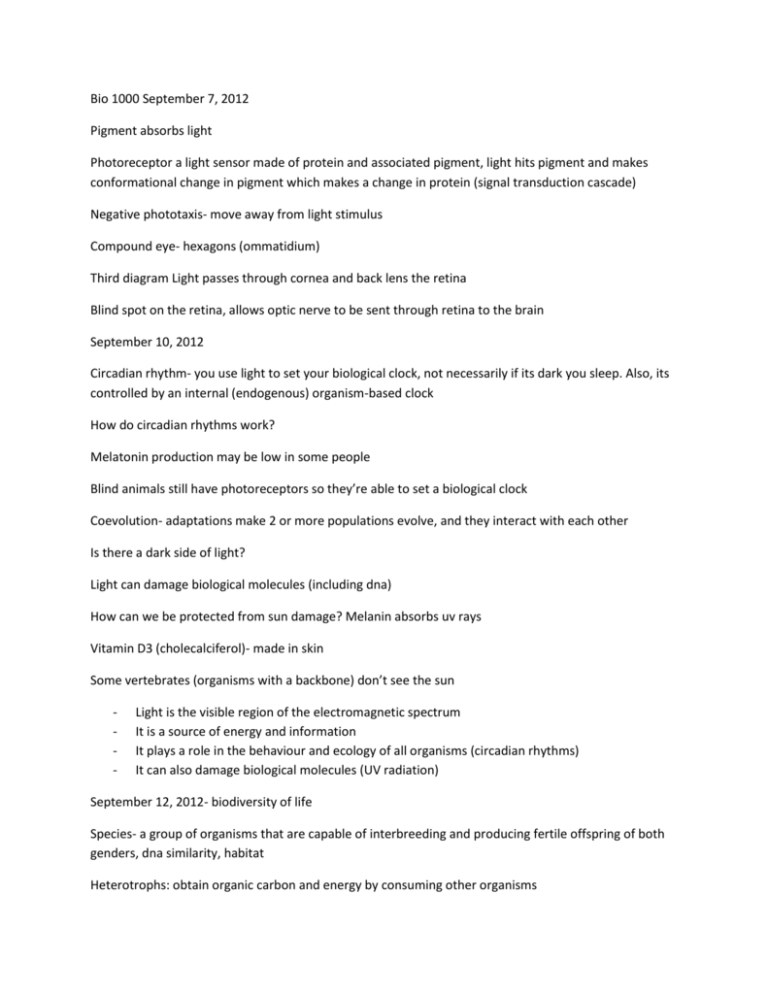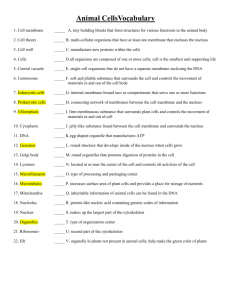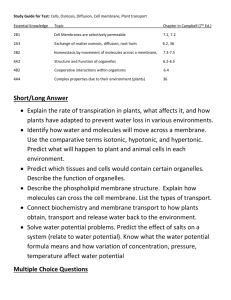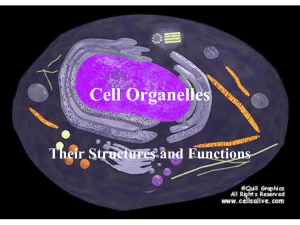bio_1000_september_7
advertisement

Bio 1000 September 7, 2012 Pigment absorbs light Photoreceptor a light sensor made of protein and associated pigment, light hits pigment and makes conformational change in pigment which makes a change in protein (signal transduction cascade) Negative phototaxis- move away from light stimulus Compound eye- hexagons (ommatidium) Third diagram Light passes through cornea and back lens the retina Blind spot on the retina, allows optic nerve to be sent through retina to the brain September 10, 2012 Circadian rhythm- you use light to set your biological clock, not necessarily if its dark you sleep. Also, its controlled by an internal (endogenous) organism-based clock How do circadian rhythms work? Melatonin production may be low in some people Blind animals still have photoreceptors so they’re able to set a biological clock Coevolution- adaptations make 2 or more populations evolve, and they interact with each other Is there a dark side of light? Light can damage biological molecules (including dna) How can we be protected from sun damage? Melanin absorbs uv rays Vitamin D3 (cholecalciferol)- made in skin Some vertebrates (organisms with a backbone) don’t see the sun - Light is the visible region of the electromagnetic spectrum It is a source of energy and information It plays a role in the behaviour and ecology of all organisms (circadian rhythms) It can also damage biological molecules (UV radiation) September 12, 2012- biodiversity of life Species- a group of organisms that are capable of interbreeding and producing fertile offspring of both genders, dna similarity, habitat Heterotrophs: obtain organic carbon and energy by consuming other organisms Autotrophs: synthesize organic carbon molecules using inorganic carbon, CO2 Photoautotrophs: Use light as source of energy for photosynthesis Chemoautotrophs: use reduced chemicals rich in electrons as an energy source Archaea and bacteria produce through binary fission Eukarya goes through sexual reproduction Similiarities between archaea, bacteria and eukarya: dna, cell membrane, translation and transcription machinery and have a way to get energy Selection-how does it relate to biodiversity? - When some force or phenomenon affects the survival and reproduction of individual organisms Selection directed by different circumstances September 14, 2012 Community- 2 or more populations living in the same area Evolution- A change in inherited traits/characteristics over time Population- group of individuals from same species that live in same area and regularly interbreed Evolution is valid science Theory of evolution- explains the unity and diversity of life - Highly fertile Food resources Genetic variation Evolution of life on our planet may have been an inevitable outcome of initial physical and chemical conditions established by Earth’s origins Anoxygenic- photosynthesis not producing oxygen, influenced by sulphur Oxygenic- photosynthesis bacteria appears oxygen produced, influenced by oxygen Bacteria could go under evolution as well (horizontal gene transfer) Hydrogen bonds hold A-T and C-G together Adenine and Thyamine have a weaker bond Linked by phosphor diesther bond September 17, 2012 Once protein starts translating with (n terminal) when its done translating we end up at the c terminal (carboxyl) Primary- amino acids in a sequence Secondary- linking between primary amino acids Tertiary- folding in amino acids Quaternary- structure of protein starts forming Redox reactions are important with metabolism Most energy is released from ATP by removing last phosphate group September 19, 2012 ORI stands for origin of replication, it starts the replication Marker- allows plasmid to grow if it has the gene MCS- has about 20 restriction sites A restriction site allows the enzyme to recognize where it can cut on the plasmid Final product is what we call recombinant DNA Putting the recombinant DNA into a bacterial cell is called transformation Bacteria competence- bacteria able to take up plasmid Ligation joining pieces of DNA, enzyme called DNA ligase Plasmid could close on its own Liquid needs to contain AMP (amphisiilan) Bacteria responds to the presence of amphisilan Selection helps determine which bacteria is growing and which contains the insert September 21, 2012 Organelle- has to have a membrane around them, have a specialized function, only be found in a eukaryote, they’re suspended within the cell cytosol Cytosol is the liquid portion of the cell Cytoplasm is liquid plus organelles Endomembrane system- vesicle allows things to fuse with organelles Nucleus is where rRna is transcribed and small and large ribosomes subunits are made Nuclear Pore- things can enter and leave Nuclear Lamina- structural support mRNA needs to get out of the nucleus Enzymes need to get in and out of the nucleus as well as ATP and ions Nucleotides, hormones, rRna, ribosomes are things that need to get in/out of the nucleus Importance of the nuclear membrane- we keep it separated because we don’t want to damage the DNA Archaea associate with histone like proteins 4 of them Image of histones- there are 8 histones, the 4 are doubled, the black is the DNA and once its wrapped around its called nucleosomes, octomer consists of H2A, H2B, H3, H4 Heterochromatin- tightly packed, you don’t want being new stuff being transcribed while it is being replicated, mostly 30nm Euchromatin- loosely packed, 10nm is more spread out September 24, 2012 Chapter 1-3, 21 and biotechnology for bio test and check moodle- NEXT WEEK Rough Endoplasmic Reticulum is covered in ribosomes (little dots) Smooth endoplasmic reticulum- plays a role in lipid synthesis, regulates calcium, carbohydrates, breaks down some drugs Vesicle- brings stuff from one organelle to another organelle Golgi apparatus- after leaving the ER, it moves to the Golgi, in the Golgi a sugar group is added to the protein which is called glycosylation (the sugar is added after the protein is translated) Lysosomes- have a very acidic environment; their pH level is around 4.8 Macrophage contains lysosomes Organelles come from pre-existing organelles Endomembrane system doesn’t include mitochondria and chloroplasts September 26, 2012 Dyneins - we find them in animal cells, some in plant cells it is used to transport vesicles and organelles - Known for flaggeral movement in Eukaryotes There has to be a motor protein for movement Dynein moves along microtubules, which allows bacteria’s flagellum to move in a whip like motion Cilia moves stuff, they are hair like structures and they can be found in the trachea (helps you sneeze) Flagella of prokaryotes and eukaryotes ARE NOT EVOLUTIONARILY RELATED Myosin moves along the actin to generate enough power which produces a muscle contraction Myosin also plays a role in cell division Mutation in kinesin (motor protein) will allow organism to not function properly Extracellular matrix is located outside the cell membrane, it is used to specialize the cell (ex. Bone, cartilage, skin, cardiac muscle, intestinal villi, skeletal muscle) ECM- helps to provide structural support and helps to provide its function (don’t confuse with mitochondrial matrix) Eukaryotic cells are bigger than prokaryotic cells because they have a bigger endomembrane, volume will increase but by having the endomembrane system the surface area will support the volume (works like a balloon blowing up) Prokaryotic cells can’t support a large surface area because there’s no room Multicellular eukaryotes evolve: First theory: The cells combined and formed a multicellular organism. Second theory: While a cell divided something went wrong and the cell ended up with different characteristics. September 28, 2012 Membrane functions- different environments MUST be maintained Lysosome has a different environment because it has a lower pH 5 million lipids for every nm Phospholipids- contain polar unit, phosphate group, glycerol, fatty acid chain x2, (polar phosphate group) Asymmetry of membranes- brown- sphingle myelin (transport signals), green- phosphapidylsirin, redphosphapidylcholine Plasma membrane is constantly moving, this fluidity is necessary to maintain the integrity of the plasma membrane Higher the temperature=more movement so it will be more fluid October 1, 2012 Saturated will become a solid first since its tightly packed together Desaturase is an enzyme to break down the fat Don’t want too many fatty acids to make membrane fluid Cholesterol inserted between phospholipids Phytosterol is a membrane fluid found in plant cell membranes Gases could pass through a selective permeability membrane, others need a concentration gradient (curved arrow on diagram needs help going through membrane) Proteins-Different membranes have different proteins and thus different functions Transport need to bring stuff in and out of cell for cellular process to happen Membrane protein could release substances into the cell and they play a role in enzyme activity Receptor proteins receive signals Attachment or cell recognition through membrane proteins October 10, 2012 Integral membrane proteins integrate through the membrane Polytopic membranes are better for proteins passing through the membrane Antarctic fish- cold-blooded- unsaturated fatty acids counteract the effects of cold; cold makes membranes less fluid, UFAs make membranes more fluid Gated Channel Proteins- switch between open or closed starts October 12, 2012 Water intoxication leads to hyponatraemia *research it* Symport- Both move in same direction Antiport- moves in opposite direction against concentration gradient Water is able to diffuse through the hydrophobic part of a cell because the lipids repel against each other making room for it to pass through October 15, 2012 Exergonic is negative because you are releasing energy, less energy in products than reactants Endergonic – you have to put energy into that system to be used Not all energy released by catabolic reactions is used for anabolic reactions 2nd law of thermodynamics- during every transfer some energy becomes unusable (not available to do work) 1st law of thermodynamics energy cannot be created of destroyed but only converted from one form to another. Conservation of energy Thermal energy important for homeotherms who use the heat to maintain their internal environment Activation energy- initial input of energy to start a reaction, even if it is spontaneous Enzymes increase the rate of a chemical reaction, they lower the activation energy of a reaction October 17, 2012 The more inhibitors the more chances of it trying to connect Allosteric activator- some things will activate once it has too much it will inactivate, without allosteric activator the activator will bind to the site and increase the infinite site Optimum ph depends on the enzyme Enzymes in a lysosome have an acidic ph to break down the cell Enzymes begin to denature once temperatures go above 40 degrees Celsius substrate level decreases Cofactors help regulate an enzymes biological activity, they can be inorganic or organic Basal metabolic rate is the same as resting rate Active metabolic rate is how much energy you need to do your daily activities Feedback inhibition- takes up till it needs it once there’s too much the body will stop it from producing it October 19, 2012 Glycolysis process is broken down to two pyruvate molecules, 2 ATP, 2NADH Pyruvate oxidation- produces acetyl COA Kreb’s Cycle- some ATP, NADH AND FADH2 Electron transport chain- Chemiosmosis associated with it, ATP is not produced by the electron transport system, the purpose of the system is to set up a proton gradient so ATP is made up after chemiosmosis *know the mitochondrion anatomy Mitochondrial matrix is not the same as the extracellular matrix Glycolysis- breaks glucose down into pyruvate - Old process as it doesn’t require oxygen, it’s the only process that doesn’t use oxygen Energy investment phase- 2 ATPs are placed Phosphorylation occurs to destabilize the glucose into 2 pyruvate NADH later takes part in the Electron Transport Chain Substrate level phosphorylate occurs in glucose- process produces ATP by removing a phosphate group to ADP in order to form ATP (kinase enzyme is key as it catalyzes the transfer of phosphate from one molecule to another) Compare molecules in this reaction: 1) Phosphate group was taken away which results in the production of ATP If the shape is changed it is called isomerization G3P2H+one H+ produces NADH G3P 2H+ one H+ produces NADH October 22, 2012 Pyruvate is oxidized into Acetyl-CoA by pyruvate hydrogenase November 5, 2012 Receptors bind to signaling molecule which causes a change and initiates signal transduction cascade Not a 1:1 relationship between molecules in the pathway Each step amplifies so the signal is stronger If phosphatase removes the kinase it becomes prohibited Cross talk- interaction between pathways - Where one thing gets activated in one pathway which results activating something else in another pathway G protein binds with first messenger causes conformational change which activates G protein, GDP is remove and GTP is added so now the G protein is active and now it moves to adenylyl cyclase which moves it to the cAMP the second messenger and then produces Protein kinase A which results in cellular responses As long as cAMP is present protein kinase will be activated Creb travels through nucleus once regulated by Protein Kinase A to initiate transcription If adenylyl cyclase is not activated, protein kinase A won’t be activated which would lead to no cellular responses If phosphodiesterase is not activated- it won’t be able to break cAMP to AMP which won’t terminate the response IP3 activates DAG and helps activate protein kinases November 16, 2012 M checkpoint- checks if spindle fibers are ready G2- checks if the DNA is replicated Cyclin dependent kinases phosphorylate other proteins but on their own theyre inactive, to be activated they bind to cyclins Phosphorylation can be used to activate or inactivate stuff Cells have metastasised when cells spread to other organs November 21, 2012 Proximal region helps in regulation Enhancer helps transcription works at maximal speed Activators when bind help turn the transcription process on, transcription factors are recruited Repressor hinder transcription factors from binding Polyadenylation- addition of poly A tail Poly A tail at the end of transcription helps signals that it is done, it assists in exporting out of the nucleus, and helps prevent the degradation Exons will be translated into protein, introns won’t so we have to get rid of them Introns are removed by splicing Alternative splicing exons can be joined in different combinations, sometimes you include all of them sometimes pieces of them










